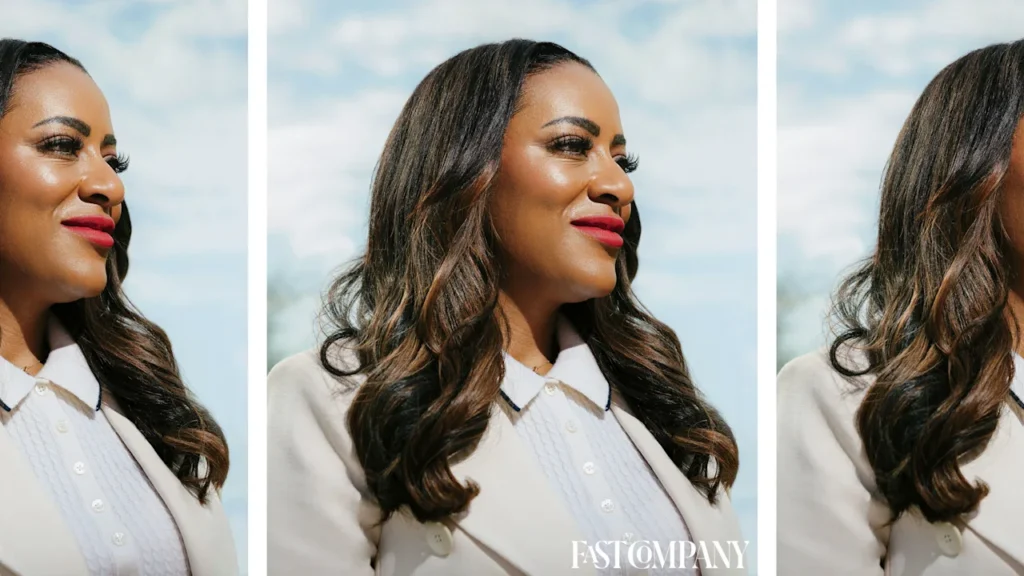
During a recent New York Fashion Week, a wood-paneled boutique popped up in SoHo next to Louis Vuitton and Bottega Veneta. On the racks were tailored, wide-leg jeans and simple black Henley dresses that signaled understated elegance. But unlike those of neighboring boutiques, the clothes weren’t from a storied European maison de couture. They were some of the newest collections from Scoop and Free Assembly, two brands led by Brandon Maxwell, creative director at the House of Walmart.
The pop-up—which featured items priced between $8 and $75—was part of the Bentonville, Arkansas–based retailer’s strategy to get its products in front of urban shoppers who might not be familiar with its growing array of fashion-forward budget brands. The SoHo stint was just one of the ways chief merchant Latriece Watkins— a 25-year veteran of the company who joined the C-suite in 2023—is positioning Walmart to appeal to a broader spectrum of shoppers. “Our goal is to refresh and elevate all of our fashion brands,” Watkins says. “We’re only 10% of the way there.”
For six decades, Walmart has been the go-to retailer for rural, lower-income Americans. But at a time of inflation and economic uncertainty, Americans of all backgrounds are more budget conscious. “Prices have gone up for three years,” says Mickey Chadha, a retail analyst at Moody’s. “Even the wealthy are looking to save money, and they’re gravitating toward Walmart.” This presents the retailer with the opportunity to win over more affluent consumers, snagging them from competitors like Target and Amazon.
Watkins has been introducing higher-end brands, like Apple, Sonos, and Nike’s Air Jordan, both into stores and on Walmart.com. Her team is also developing and refreshing private labels that look premium but are inexpensive, with a focus on growth areas, such as apparel. In addition to working with Maxwell to reimagine the Scoop and Free Assembly lines, Walmart relaunched No Boundaries last year. The 30-year-old fashion brand, which generates $2 billion a year, has been updated to appeal to the tastes of Gen Z, with prices under $15. This July, the company unveiled Weekend Academy, a new trendy label for tweens.
Watkins is also targeting Walmart’s grocery business, which makes up 60% of its sales. Last April, the company launched Bettergoods, its first new private-label food brand in two decades; the line of 400 attractively packaged globally inspired food items has quickly lured new customers into stores. “They’re already among the fastest-moving items we sell,” Watkins says.
The strategy is working: While roughly 45% of Walmart’s customers earn less than $50,000 a year and only 7% earn more than $100,000, the company’s share of high-income customers is expanding. In the first half of 2024, households earning more than $200,000 drove growth in the grocery business, making up 8% of customers. And in the third quarter of 2024, customers who earn more than $100,000 accounted for 75% of Walmart’s gains in market share, a trend that continued in 2025. Now, Watkins’s challenge is to continue winning over deeper-pocketed customers while keeping the budget-conscious ones happy. “We have a core customer we will never alienate,” she says. “But we now have an opportunity to delight them with merchandise that goes beyond the essentials.”
The typical Walmart store looks nothing like its swanky New York pop-up. Under fluorescent lights, you’ll find aisles stacked with 120,000 products, from cereal to apples to sneakers to candles. Watkins’s team of merchants selects every one of these goods. Just as importantly, they’re responsible for how much each item costs. “As merchants, we take a ton of responsibility for the prices customers see,” Watkins says.
Price has always been Walmart’s critical advantage. When Sam Walton founded the company in 1962, he had the radical idea of selling products as cheaply as possible when the conventional wisdom among retailers was to charge the highest price the customer was willing to pay. Walton’s approach meant lower margins, so he focused on selling in volume, creating vast stores in small, rural towns underserved by other retailers.
By pursuing this approach—the most successful in retail history—Walmart has become the largest company in the world by revenue, to the tune of $681 billion in 2024. It has 10,750 stores in 19 countries. In the United States, its 4,605 stores are within 10 miles of 90% of the population. And since Walmart’s prices remain 10% to 25% lower than those of its competitors, it often serves as the primary retailer for low-income families in nonmetropolitan areas, according to research by the Analysis Group. Watkins has no intention of changing this. “We’re going to keep serving the customer who has trusted us for years,” she says.
Yet Watkins believes her team has an opportunity to serve a wider demographic by adding more products to the assortment. Walmart’s merchants track the tastes of higher-income consumers and bring in premium brands that will appeal to them. In recent years, that’s included Oxo kitchenware, De’Longhi coffee makers, and La Roche-Posay skincare. Walmart pores over its store data, selectively placing these higher-end products in areas with higher incomes. All of them also appear on Walmart’s website, which includes half a billion items. “It’s a formula that’s working,” says Chadha. “Walmart is growing year over year by gaining customers on the high end without losing customers on the low end.”
But adding upscale brands can only take a retailer so far. The way to turn someone into a regular Walmart customer is to get them hooked on products they can’t get elsewhere—which is why Watkins is so focused on bolstering the company’s private labels. “We want to have an assortment of items that customers want to repeat-purchase,” says Watkins. “If you make an item people love, they will come back for it again and again.”
Of Walmart’s 90 house brands, 22 generate upwards of a billion dollars in annual revenue, including Wonder Nation kids’ clothing, Ozark Trail outdoor gear, and Onn electronics, which includes TVs and tablets. These brands have historically focused on no-frills essentials. But to appeal to richer customers, Watkins is rolling out in-house brands that focus on quality and design.
The move is straight out of Target’s playbook at a time when the Minneapolis-based retailer is flagging. Over the past two decades, while Walmart was serving rural, working-class Americans, Target was capturing trendy urbanites by focusing on good design. Target partnered with high-end designers to create cheaper versions of their products and launched private labels that mimicked the popular new brands on the market. But over the last year, Target’s sales have declined amid operational challenges and boycotts from consumers over its reversal on DEI initiatives. This has given Walmart an opportunity to win over some of Target’s waffling shoppers.
Bettergoods is Walmart’s first big play to steal Target’s thunder. After researching food trends, Watkins’s team noticed that Walmart’s customers were looking for more global flavors, plant-based ingredients, and foods that cater to dietary restrictions. “Our food business is so large that we have insight into everything that’s happening in the food industry,” she says. “It was clear that the customer profile was changing.” In response, the company developed Bettergoods specialty grocery items, including macarons, gochujang sauce, and mushroom umami seasoning, that wouldn’t be out of place at a pricier retailer. Even so, 70% of Bettergoods products cost less than $5.
While other Walmart food brands have a budget aesthetic, Bettergoods has a custom typeface and multicolor packaging that looks as good as in-house brands at Target and Whole Foods. This positioning is paying off. So far, 60% of people who buy the brand have never previously purchased from Walmart’s private labels, and their repurchase rate is 40%. Bettergoods also introduces shoppers to other Walmart offerings. “Walmart is succeeding at picking up a share of the wealthy consumer’s basket,” says Sucharita Kodali, a retail analyst at Forrester. “If they start shopping at Walmart for food, they may pick up tablecloths, bug sprays, and socks.”
To help build knowledge of its house brands outside the store, Walmart has recently created an influencer network to showcase its private labels on social media, and last fall, it embarked on a 29-city “Style Tour” in a blue camper van that let people shop items from 15 of its fashion labels. “We’ve been able to expose our assortment to people who don’t have stores as close to them but can access these products the same or next day by shopping online,” Watkins says. “Our differentiator is our ability to serve customers in multiple ways, all at the same time.”
Thanks to Watkins’s merchandising strategy, more high-income consumers are now online-only Walmart shoppers—an important step in helping Walmart catch up to Amazon’s e-commerce dominance. Over the last decade, Walmart has invested in its website, from launching a third-party marketplace to improving delivery speeds to offering a Prime-like membership program called Walmart+. At $100 billion, Walmart’s online sales are significantly smaller than Amazon’s $480 billion, but they are growing twice as fast—by 20% in 2024, compared to Amazon’s 11% sales growth. Last year, Walmart dispatched 6.5 billion items via same- or next-day delivery. “The e-commerce capabilities of Walmart and Amazon are head-to-head at this point,” says Chadha. “Walmart’s advantage is that it has a significant store footprint, which they can integrate into their e-commerce by turning them into distribution centers.”
In some cases, Watkins says wealthy consumers order from Walmart’s website in order to shop the budget retailer discreetly, but she believes elevating product design and quality will help change people’s perceptions. “I received a note from someone who said she got so many compliments on a dress she wore to her friend’s wedding. No one knew it was from Walmart,” she says. “We’re focused on being a place where people feel so good about their purchases, they want to tell their friends about it.”





